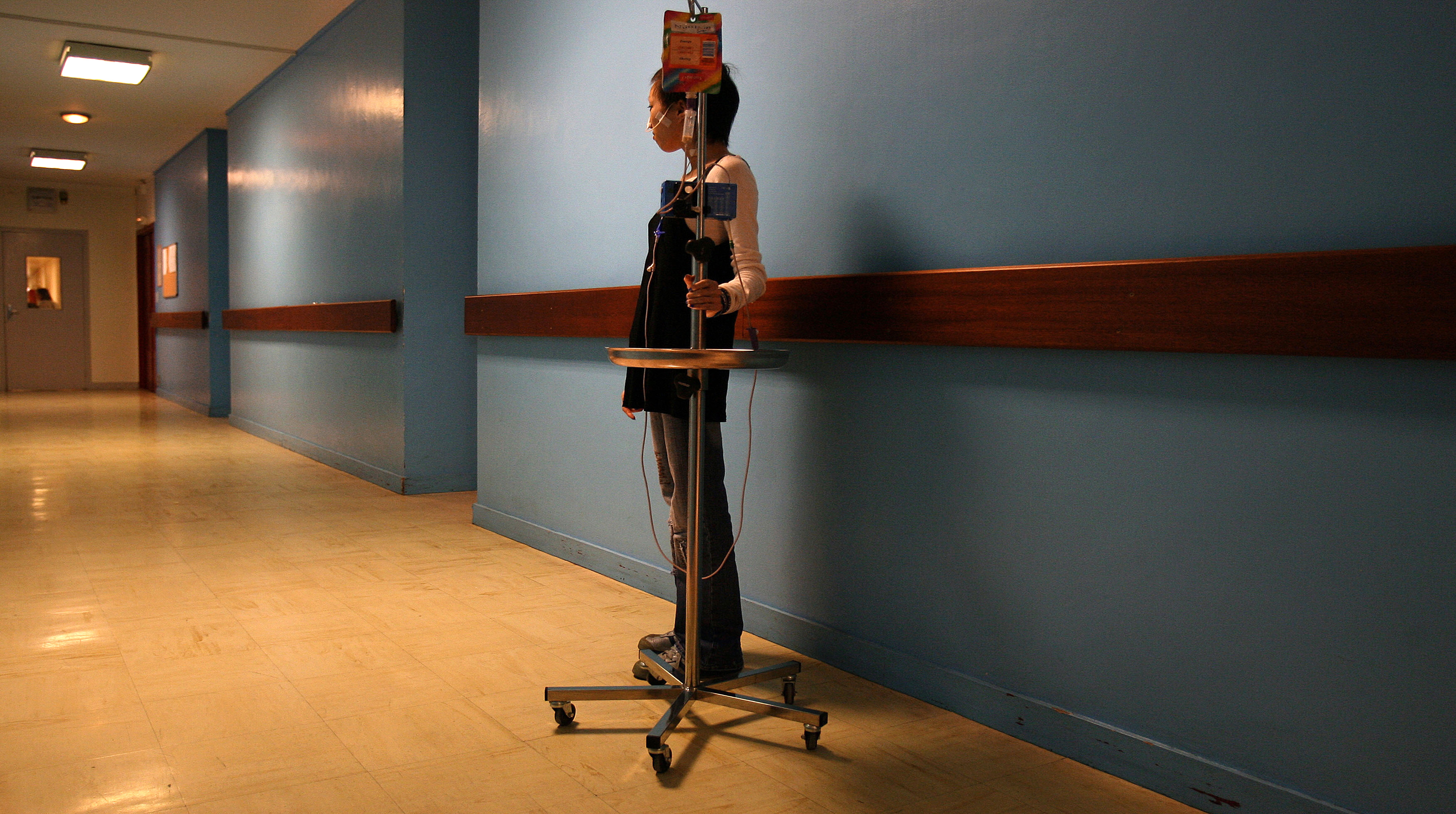Treating eating disorders in Switzerland

Starving and gorging. Self-control and powerlessness. Extremes characterise the eating disorders of anorexia, bulimia and binge eating. The tens of thousands of people affected in Switzerland share a common bond: an obsession with food.
Described variously as addictions and diseases, eating disorders afflict 3.5 per cent of the Swiss population at some point in their lives, with 1.1 per cent currently suffering from a disorder, according to a 2012 survey of 10,038 people aged 15 to 60 in Switzerland.
The study, conducted by researchers from Zurich University and commissioned by the Federal Health Office, looked at the prevalence of eating disorders among a broad population and is thought to be the most extensive worldwide.
“When it comes to eating disorders, the tabloid press tends to make out that every second person has an eating disorder and that the number is increasing exponentially,” said Gabriella Milos, one of study authors and head of the centre for eating disorders in the department of psychiatry at Zurich University Hospital.
“Scientifically, we’re much more cautious. To truly be able to say whether the number is increasing or decreasing or staying the same requires meticulous collection of data. And that hasn’t been done in Switzerland up until now,” she told swissinfo.ch.
Eating disorders certainly seem to be the object of increasing media attention. In September this included published excerpts of the memoir of a 20-year-old recovered anorexic and a television interview with Tanja Baumann, a former anorexic who went on to become a fitness world champion.
Baumann, now 38, suffered from anorexia for seven years. “It’s such a dark place to be in. It’s a lonely place. You feel so guilty,” she told swissinfo.ch.
She believes involvement in sport helped her overcome her disease. At the age of 20 she started competing in fitness competitions and realised: “Hey, I’ve got to add some muscle, and I can’t add muscle without eating.”
When weight is a problem
In Switzerland, where four in ten adults – 39 per cent – are technically overweight, with a body mass index of 25 or greater (see sidebar), the Federal Health Office has made overweight prevention and therapy a priority. But being overweight is only part of the problem.
Eating disorders and other self-destructive eating behaviours cost Swiss society around SFr200-250 million ($213-266 million) a year, estimates PEP, an eating disorders prevention centre based at the Bern University Hospital and supported in part by the Federal Health Office.
Binge eaters are significantly more overweight than people who do not have eating disorders, whereas bulimics, who use vomiting and laxatives to rid their bodies of food, are generally of average weight.
Although anorexics’ extremely low weights can be life-threatening, the dangers of being underweight are much less recognised by society, says the Zurich study.
Reaching out
How to reach those suffering was the subject of a 2009 interview-based study conducted by social work students at the University of Applied Arts and Sciences in Northwestern Switzerland. The study analysed the services provided to patients with eating disorders through local treatment and information centres in German-speaking Switzerland.
It concluded that consultation, outpatient therapy and triage were well covered but more work was needed in prevention and early detection. It recommended providing information and training for students, parents, teachers, doctors and members of sports clubs, as well as targeted publicity.
However implementing the study’s recommendations at the federal level appears difficult.
The Federal Health Office told swissinfo.ch that the “training of teachers and other operators within the Swiss education system requires decision making by the cantons”, due to the Swiss federalist system.
For its part, Health Promotion Switzerland, a national public foundation, has not planned any national or cantonal eating disorder prevention campaigns for 2013. Exactly how and to what extent the Health Office will be active in the area of eating disorders in the future is “currently being clarified”.
Help
As it stands, various treatments are available for sufferers. In addition to individual therapy, support groups, and outpatient clinics, patients who need intensive help can apply to an inpatient programme.
“When they come to us they’re relatively insecure about how much and how often they should eat, regardless of whether they’re overweight, of normal weight, or even underweight,” says Martina Scheibel, medical director of Clinic Wysshölzli in canton Bern. “They have to have a lot of trust that we know what’s right. They give that responsibility to us.”
Generally, the patients who come to an inpatient clinic are motivated to change, says Scheibel. Sometimes a patient who was sent by her family leaves the clinic after a short stay, only to come back six months later because “now she wants to come for herself”.
Eating disorders often take a toll on family members and partners, who feel powerless. “For people close to the victims the situation is generally very difficult to witness and to endure,” says the Arbeitsgemeinschaft Ess-Störungen, an association for eating disorders.
Most family members don’t know how to deal with the patient. Discussion and confrontation provide an important, often decisive impetus for the person to seek help.
Role models can help too. Tanja Baumann cites Princess Diana of Wales, who struggled with bulimia in the 1980s and 1990s. “She did such a big thing by opening up. You felt like, ‘I’m not so different. There are other sufferers, and we don’t need to keep this quiet.’”
Often peers are an important source of support, sharing their experiences and insight. But as just one “recovery blogger” emphasises, getting better is not just the responsibility of doctors or psychiatrists: the person with the problem has to take responsibility as well.
Eating disorders can go on for decades; the average length is six years. The message to be learned, according to Baumann: “You’re valuable, whatever shape or size you are – as hard as it is to believe when you look in the mirror.”
Anorexia nervosa is characterised by a body weight under 85 per cent of normal weight, severe fear of gaining weight, a disturbed perception of one’s body and weight, and amenorrhea (cessation of the menstrual cycle for at least three consecutive months).
Bulimia nervosa involves the consumption of very large amounts of food within a short period of time (up to two hours) at least twice a week, inability to control the eating attack, and an attempt to avoid weight gain through vomiting, laxatives, diuretics, fasting, and excessive sport.
Binge eating disorder also involves consumption of large amounts of food in fewer than two hours and loss of control during the eating attack. Often the person is not hungry, eats alone, eats to the point of feeling uncomfortably full, eats very fast, and feels disgusted or guilty following the attack. However, no measures are taken to get rid of the food.
Body Mass Index (BMI) is commonly used to classify underweight, overweight and obesity in adults. It is defined as the weight in kilograms divided by the square of the height in metres (kg/m2). Underweight is defined as BMI less than 18.49, normal weight is 18.5 to 24.99, overweight is 25 to 29.99 and obese is more than 30.
According to the 2012 Zurich University study, the lifetime prevalence of anorexia, bulimia and binge eating disorder in Switzerland was 1.2%, 2.4% and 2.4% for women and 0.2%, 0.9% and 0.7% for men. The ratio of men to women was around 1:3 for bulimia and binge eating and 1:6 for anorexia.
Compared with the United States, Switzerland appears to have about the same prevalence of anorexia, more cases of bulimia, and a much lower prevalence of binge eating. Comparisons with other European countries are not possible due to differences in study design and sample size.
Eating disorders treatment can include, among other things, nutritional counselling, behaviour modification approaches, individual and group therapy, relaxation therapy, art therapy, work therapy, and medication. Bulimia responds well to cognitive behavioural therapy and psychopharmacotherapy. Self-help groups and internet forums can serve as a source of support.
As an example of inpatient treament, Clinic Wysshölzli in canton Bern has 17-19 spots for adult women with eating disorders. Treatment lasts a minimum of 12 weeks and an average of 19. The cost – covered by insurance and the patient’s canton – is SFr 415 per day.

In compliance with the JTI standards
More: SWI swissinfo.ch certified by the Journalism Trust Initiative



You can find an overview of ongoing debates with our journalists here. Please join us!
If you want to start a conversation about a topic raised in this article or want to report factual errors, email us at english@swissinfo.ch.